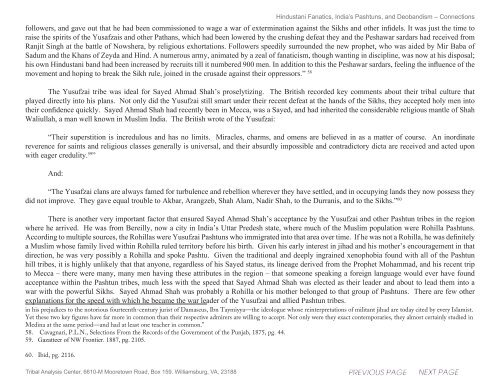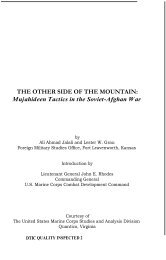Hindustani Fanatics, India’s Pashtuns, <strong>and</strong> Deob<strong>and</strong>ism – Connectionsthat he had prepared a contingency plan in case of his death after which his disappearance would allow his heirs to claim that he was now a “HiddenImam” who was continuing the jihad from a cave, again borrowing from the Shi’a.Again, it is Charles Allen who got this part of history right:“Various qualifications were required of the Imam-Mahdi. He would be an imam <strong>and</strong> a caliph, bear the name Muhammad, be a descendentof the Prophet through his daughter Fatima, arise in Arabia <strong>and</strong> be forty years old at the time of his emergence. Syed Ahmad Shah fulfilled the mostimportant of these qualifications: he was a Saiyyed, had been raised as ‘Muhammad’ (of which ‘Ahmad’ was a diminutive), <strong>and</strong> he became forty in1826. In January of that year he began his hijra accompanied by a b<strong>and</strong> of some four hundred armed <strong>and</strong> committed jihadis.” 54The British seem to have generally ignored Sayed Ahmad Shah’s activities. His stated enemies were the Sikhs <strong>and</strong> it is very probable that aslong as the Islamic revolutionaries surrounding him were focused on the Sikhs, the British derived some benefit from their activities. According toHafeez Malik, “When two thous<strong>and</strong>s Moslems had congregated in Rai Bareli to sacrifice their lives in the war with the Sikhs, Shahid decided that thetime was right.” 55His route westward had to bypass the Sikh territories of Ranjit Singh <strong>and</strong> this newly created Amir of India’s jihadis departed Tonk’s relativesafety along a southerly route through Sind <strong>and</strong> across Baluchistan through six hundred miles of difficult, sometimes desert terrain to Afghanistan’sK<strong>and</strong>ahar before they turned toward the north to Kabul. Finding little support there, Sayed Ahmad Shah’s little army marched east through theKhyber Pass to arrive in the vicinity of Peshawar.A man who lost his life while working among the Pashtuns, Sir Pierre Louis Napoleon Cavagnari, wrote about the arrival of Sayed AhmadShah into Yusufzai territory:“About the year 1823 appeared one of those religious impostors on the arena of Yusafzai politics who have at all times <strong>and</strong> seasons beguiledthe incredulous <strong>and</strong> simple Pathan race for their own ends, <strong>and</strong> have been the means of creating discord, up-heaving society, <strong>and</strong> fomenting rebellionswhich have been checked <strong>and</strong> crushed with the utmost difficulty. The career of Pir Tarik in the 17 th century, <strong>and</strong> that of Sayad 56 Ahmad of Bareilly<strong>and</strong> the Akhud of Swat in the 19 th century, show but too clearly what single men are able to perform amongst the credulous Pathans. This man wasSayad Ahmad Shah 57 , a resident of Bareilly, who, after visiting Mecca-Kabul, suddenly appeared in the Peshawar district with about 40 Hindustani54. Ibid, pg. 79.55. Hafeez Malik, pg. 165.56. This paper uses the original rendering of this name.57. Allen, Charles, The Hidden Roots of Wahhabism in British India, World Policy Journal, Summer, 2005. Allen wrote “The man credited with importing Wahhabism intoIndia is Syed Ahmad of Rae Bareili (1786–1831), who returned from pilgrimage in Mecca in 1824 to begin a holy war against the Sikhs aimed at restoring the Punjab to Muslimrule. But the argument that Syed Ahmad picked up his ideas of Wahhabi intolerance <strong>and</strong> jihad while in Arabia is untenable. The reality is that he had already accepted the basictenets of Wahhabism long before sailing to Arabia, as a student of the Madrassa-i-Ramiyya religious seminary in Delhi <strong>and</strong> as a pupil of its leader, Shah Abdul Aziz, son of thereformer Shah Waliullah of Delhi. Shah Waliullah is the key figure here— a man as much admired within Sunni Islam as a great modernizer (the historian Aziz Ahmad rightlydescribes him as “the bridge between medieval <strong>and</strong> modern Islam in India”) as Abd al-Wahhab is reviled. The one, after all, was a follower of the tolerant, inclusive Hanafi schoolof jurisprudence <strong>and</strong> a Naqshb<strong>and</strong>i Sufi initiate, while the other belonged to the intolerant, exclusive Hanbali school, was viciously anti-Sufi <strong>and</strong> anti-Shia, <strong>and</strong> deeply indebtedTribal Analysis Center, 6610-M Mooretown Road, Box 159. Williamsburg, VA, 23188
Hindustani Fanatics, India’s Pashtuns, <strong>and</strong> Deob<strong>and</strong>ism – Connectionsfollowers, <strong>and</strong> gave out that he had been commissioned to wage a war of extermination against the Sikhs <strong>and</strong> other infidels. It was just the time toraise the spirits of the Yusafzais <strong>and</strong> other Pathans, which had been lowered by the crushing defeat they <strong>and</strong> the Peshawar sardars had received fromRanjit Singh at the battle of Nowshera, by religious exhortations. Followers speedily surrounded the new prophet, who was aided by Mir Baba ofSadum <strong>and</strong> the Khans of Zeyda <strong>and</strong> Hind. A numerous army, animated by a zeal of fanaticism, though wanting in discipline, was now at his disposal;his own Hindustani b<strong>and</strong> had been increased by recruits till it numbered 900 men. In addition to this the Peshawar sardars, feeling the influence of themovement <strong>and</strong> hoping to break the Sikh rule, joined in the crusade against their oppressors.” 58The Yusufzai tribe was ideal for Sayed Ahmad Shah’s proselytizing. The British recorded key comments about their tribal culture thatplayed directly into his plans. Not only did the Yusufzai still smart under their recent defeat at the h<strong>and</strong>s of the Sikhs, they accepted holy men intotheir confidence quickly. Sayed Ahmad Shah had recently been in Mecca, was a Sayed, <strong>and</strong> had inherited the considerable religious mantle of ShahWaliullah, a man well known in Muslim India. The British wrote of the Yusufzai:“Their superstition is incredulous <strong>and</strong> has no limits. Miracles, charms, <strong>and</strong> omens are believed in as a matter of course. An inordinatereverence for saints <strong>and</strong> religious classes generally is universal, <strong>and</strong> their absurdly impossible <strong>and</strong> contradictory dicta are received <strong>and</strong> acted uponwith eager credulity. 59 ”And:“The Yusafzai clans are always famed for turbulence <strong>and</strong> rebellion wherever they have settled, <strong>and</strong> in occupying l<strong>and</strong>s they now possess theydid not improve. They gave equal trouble to Akbar, Arangzeb, Shah Alam, Nadir Shah, to the Durranis, <strong>and</strong> to the Sikhs.” 60There is another very important factor that ensured Sayed Ahmad Shah’s acceptance by the Yusufzai <strong>and</strong> other Pashtun tribes in the regionwhere he arrived. He was from Bereilly, now a city in India’s Uttar Predesh state, where much of the Muslim population were Rohilla Pashtuns.According to multiple sources, the Rohillas were Yusufzai Pashtuns who immigrated into that area over time. If he was not a Rohilla, he was definitelya Muslim whose family lived within Rohilla ruled territory before his birth. Given his early interest in jihad <strong>and</strong> his mother’s encouragement in thatdirection, he was very possibly a Rohilla <strong>and</strong> spoke Pashtu. Given the traditional <strong>and</strong> deeply ingrained xenophobia found with all of the Pashtunhill tribes, it is highly unlikely that that anyone, regardless of his Sayed status, its lineage derived from the Prophet Mohammad, <strong>and</strong> his recent tripto Mecca – there were many, many men having these attributes in the region – that someone speaking a foreign language would ever have foundacceptance within the Pashtun tribes, much less with the speed that Sayed Ahmad Shah was elected as their leader <strong>and</strong> about to lead them into awar with the powerful Sikhs. Sayed Ahmad Shah was probably a Rohilla or his mother belonged to that group of Pashtuns. There are few otherexplanations for the speed with which he became the war leader of the Yusufzai <strong>and</strong> allied Pashtun tribes.in his prejudices to the notorious fourteenth-century jurist of Damascus, Ibn Taymiyya—the ideologue whose reinterpretations of militant jihad are today cited by every Islamist.Yet these two key figures have far more in common than their respective admirers are willing to accept. Not only were they exact contemporaries, they almost certainly studied inMedina at the same period—<strong>and</strong> had at least one teacher in common.”58. Cavagnari, P.L.N., Selections From the Records of the Government of the Punjab, 1875, pg. 44.59. Gazatteer of NW Frontier. 1887, pg. 2105.60. Ibid, pg. 2116.Tribal Analysis Center, 6610-M Mooretown Road, Box 159. Williamsburg, VA, 23188
- Page 7 and 8: Hindustani Fanatics, India’s Pash
- Page 9 and 10: Hindustani Fanatics, India’s Pash
- Page 11 and 12: Hindustani Fanatics, India’s Pash
- Page 13 and 14: Hindustani Fanatics, India’s Pash
- Page 15: And Charles Allen described the sce
- Page 19 and 20: Charles Allen provided additional d
- Page 21 and 22: Hindustani Fanatics, India’s Pash
- Page 23 and 24: Hindustani Fanatics, India’s Pash
- Page 25 and 26: Hindustani Fanatics, India’s Pash
- Page 27 and 28: Hindustani Fanatics, India’s Pash
- Page 29 and 30: that Shah Waliullah’s ancestors w
- Page 32: Hindustani Fanatics, India’s Pash
- Page 35 and 36: Hindustani Fanatics, India’s Pash
- Page 37 and 38: Hindustani Fanatics, India’s Pash
- Page 39: Hindustani Fanatics, India’s Pash
- Page 42 and 43: Hindustani Fanatics, India’s Pash
- Page 44 and 45: Hindustani Fanatics, India’s Pash
- Page 46 and 47: Hindustani Fanatics, India’s Pash
- Page 48 and 49: Hindustani Fanatics, India’s Pash
- Page 50 and 51: Hindustani Fanatics, India’s Pash
- Page 52 and 53: Hindustani Fanatics, India’s Pash
- Page 54 and 55: Hindustani Fanatics, India’s Pash
















